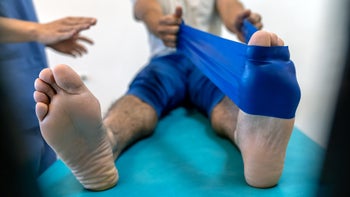
How to Choose Shoes for Plantar Fasciitis
Key takeaways:
Plantar fasciitis is a common foot condition that causes heel pain.
Wearing supportive shoes –– and replacing them when they’re worn out –– can help treat plantar fasciitis.
There is no best shoe for plantar fasciitis. Consider shoes with arch support, cushioned soles, and a slight heel to help relieve foot pain.

Plantar fasciitis is one of the most common causes of foot pain. It occurs when the plantar fascia –– a thick band of tissue that connects your heel to your toes –– gets inflamed. It can affect one or both feet.
People with plantar fasciitis often have pain at the bottom or innermost part of the heel. The pain usually worsens with weight bearing or getting out of bed in the morning.
Plantar fasciitis can affect people of all ages and activity levels, from young athletes to older adults who are more sedentary. But it is more common in runners, women, and those between the ages of 40 and 60.
Search and compare options
Fortunately, most cases of plantar fasciitis heal with proper treatment. Simple treatments typically include stretching, modifying activity, and wearing supportive shoes. Here are some expert tips to help you find the best shoes to manage your plantar fasciitis.
What should you look for in plantar fasciitis shoes?
When choosing shoes for plantar fasciitis, the goal is to find footwear that ease pain and discomfort as you heal. This is critical because unsupportive footwear can worsen plantar fasciitis and limit your daily activities.
Strong arch support
Shoes with proper arch support absorb shock as you move. They are designed to distribute your weight evenly and stabilize your feet. This may reduce pressure on the plantar fascia and joints such as the hip, knee, and ankle. Less strain and weight on your joints may decrease pain and improve foot function.
That's why experts often recommend custom or over-the-counter orthotics like arch supports for people with plantar fasciitis. Research suggests that OTC orthotics may be more effective than custom-made options. But you might not need either if you find shoes with a built-in arch. This built-in support should conform to your natural arches.
Adequate arch support will vary depending on the structure of your feet. For example, people with flat feet and those with high arches may need different support. Talk to a podiatrist if you're unsure about the best option. They can help you learn more about the shape of your feet, your gait or walking pattern, and the best shoes to help treat plantar fasciitis.
Cushioned soles
Experts also recommend shoes with thick soles to absorb shock. Thick soles, including midsole and insole cushioning –– often made of foam, gel, or cork –– support the entire foot, from the forefoot to the heel. The extra layers between your feet and the ground can reduce stress on the plantar fascia and relieve pain with standing, walking, or running.
Rocker shoes, which have thick soles and rounded bottoms, have also been shown to ease foot pain from plantar fasciitis. They may be especially effective when combined with orthotics. But again, adequate cushioning depends on your foot structure and preferences.
Look for shoes with thick soles, deep heel cups, and cushioned insoles until you find the right fit. Consider shoes with removable insoles, as they allow you to add orthotics if the built-in cushioning isn't quite right for you.
Elevated heels
Heel height is another important factor when choosing shoes for plantar fasciitis. High heels and flats increase the strain on your feet. But a slightly elevated heel may lower the strain and help alleviate heel pain. According to a 2022 study, shoes with a heel height from 0.1 to 1.5 inches may be best for plantar fasciitis. You can find a slight heel in a range of footwear, including running and walking shoes.
What are the best shoes for plantar fasciitis?
There is no best shoe for plantar fasciitis because the condition affects people differently. Prioritize comfort and fit when choosing shoes for plantar fasciitis. And remember to select footwear based on your activities. For example, you might wear training shoes during a resistance workout and walking shoes while working.
Try to be patient. Finding comfortable shoes may take some trial and error. With guidance from your healthcare provider, you should be able to find different shoe styles –– from sneakers to contoured sandals –– to suit your needs.
Consider starting your search with these footwear brands approved by the American Podiatric Medical Association:
What shoes should you avoid if you have plantar fasciitis?
If you have plantar fasciitis, you'll want to avoid shoes that increase the load on your feet or impair your gait, including:
Old or worn-out footwear with less shock absorption, especially if you stand for long periods or run often
Minimalist shoes with thin, uncushioned soles
Zero-drop shoes with flat soles
Shoes with rigid soles
The bottom line
Supportive footwear is one of several effective and noninvasive ways to help you manage plantar fasciitis. But there's no one-size-fits-all approach to finding shoes for plantar fasciitis. And what works for some may not work for others.
Start by looking for shoes with arch support, cushioned soles, and a slightly elevated heel. Remember to talk to your healthcare provider for customized guidance on the best shoes for plantar fasciitis.
Why trust our experts?



References
Cho, Y. J., et al. (2022). Change of in-shoe plantar pressure according to types of shoes (flat shoes, running shoes, and high heels). Clinics in Orthopedic Surgery.
Edge Research. (2014). Public opinion research on foot health and care: Findings from a survey of 1000 US adults. American Podiatric Medical Association.
Goff, J. D., et al. (2011). Diagnosis and treatment of plantar fasciitis. American Family Physician.
Latt, L. D., et al. (2020). Evaluation and treatment of chronic plantar fasciitis. American Orthopaedic Foot and Ankle Society.
Nahin, R. L. (2018). Prevalence and pharmaceutical treatment of plantar fasciitis in United States adults. The Journal of Pain: Official Journal of the American Pain Society.
OrthoInfo. (2022). Plantar fasciitis and bone spurs.
Peng, Y., et al. (2021). Influence of arch support heights on the internal foot mechanics of flatfoot during walking: A muscle-driven finite element analysis. Computers in Biology and Medicine.
Poenaru, D., et al. (2021). Therapeutic considerations for patients with chronic plantar fasciitis (review). Medicine International.
Ribeiro, A. P., et al. (2022). The effect of short and long-term therapeutic treatment with insoles and shoes on pain, function, and plantar load parameters of women with plantar fasciitis: A randomized controlled trial. Medicina.
Schuitema, D., et al. (2019). Effectiveness of mechanical treatment for plantar fasciitis: A systematic review. Journal of Sport Rehabilitation.
Temple Orthopaedics and Sports Medicine Program. (2021). Why flip flops are bad for your feet. Temple Health.
Trojian, T., et al. (2019). Plantar fasciitis. American Family Physician.
Umar, H., et al. (2022). Impact of routine footwear on foot health: A study on plantar fasciitis. Journal of Family Medicine and Primary Care.

























